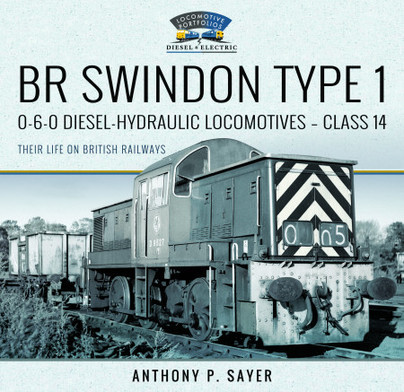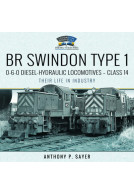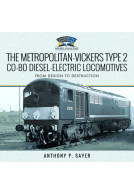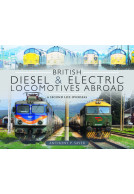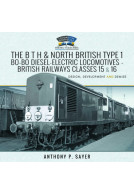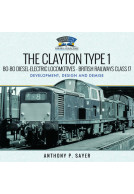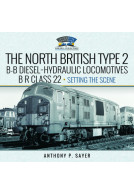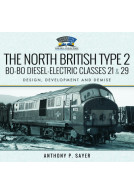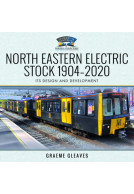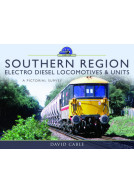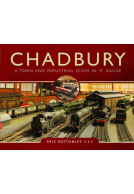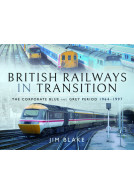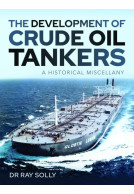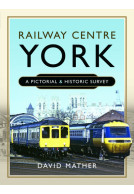BR Swindon Type 1 0-6-0 Diesel-Hydraulic Locomotives - Class 14 (Hardback)
Their Life on British Railways
Imprint: Pen & Sword Transport
Series: Locomotive Portfolios Diesel and Electric
Pages: 216
Illustrations: 280 colour & black and white illustrations
ISBN: 9781526792372
Published: 2nd March 2022
(click here for international delivery rates)
Order within the next 7 hours, 26 minutes to get your order processed the next working day!
Need a currency converter? Check XE.com for live rates
| Other formats available - Buy the Hardback and get the eBook for £1.99! | Price |
|---|---|
| BR Swindon Type 1 0-6-0 Diesel-Hydraulic… ePub (90.7 MB) Add to Basket | £15.59 |
In 1957 the Western Region of BR identified a need for 400 Type 1 diesel locomotives for short-haul freight duties but it was 1964 before the first was introduced. General-purpose Type 1s were being delivered elsewhere but WR management regarded these as too expensive for their requirements. After completion of design work on the ‘Western’ locomotives, Swindon turned to creating a cheap ‘no-frills’ Type 1. At 65% of the cost of the Bo-Bo alternative, the Swindon 0-6-0 represented a better ‘fit’ for the trip-freight niche. Since 1957 the privatised road-haulage industry had decimated BR’s wagon-load sector; whilst the 1962 Transport Act released BR from its financially-debilitating public-service obligations, the damage had been done, and the 1963 Beeching Plan focused on closing unprofitable routes and associated services. By 1963 the original requirement for 400 Type 1s had been massively reduced. Fifty-six locomotives were constructed in 1964/65. Continuing traffic losses resulted in the whole class becoming redundant by 1969. Fortuitously, a demand for high-powered diesels on the larger industrial railway systems saw the bulk of the locomotives finding useful employment for a further twenty years. This book covers the life of these locomotives on British Railways; a companion volume will provide an extensive appraisal of "Their Life in Industry" for the forty-eight locomotives which made the successful transition after withdrawal from BR
As featured by
The Broad Gauge Society
With such a cuddly-sounding nickname, BR’s Type 1 diesel-hydraulics (later Class 14) have certainly been popular with enthusiasts since their introduction in 1964. Designed by the Western Region primarily for trip freight work, a fleet of 56 locomotives was constructed at Swindon Works. Alas, with freight traffic levels plummeting, the fleet was rendered redundant before the decade was out.
Model Rail Magazine
Industry came to the rescue, however, with 48 locomotives taken on by a range of employers, most notably the National Coal Board. Examples also worked at cement works, oil refineries, quarries and steel works around the UK, with many finding their way into preservation and some even working abroad.
Anthony P Sayer’s two volumes offer a comprehensive history of the fleet as a whole and individually, across their BR and industrial careers. Indeed, virtually everything you need to know about the Type 1s is presented in these copiously illustrated - and attractively produced - hardback volumes.
Modellers will appreciate the lists of detail differences, liveries and numbers, allocations and modifications for every locomotive. Photographic coverage of all examples is also impressive. With RTR Class 14s now available in ‘N’, ‘OO’ and ‘O’, these books provide the perfect companion to a miniature ‘Teddy Bear’. Highly recommended.
The book contains detail of technical aspects, construction, use and disposal, with a full list of dates and numbers. Each locomotive is also assigned a page with its full history, in the style of the author’s previous books. A follow-up volume covering their time in industry is promised to this definitive history.
Trackside magazine
Review as featured in
Rail Express - October 2022
This 214 page work follows the same successful format employed in the author’s other books in Pen & Sword’s ‘Locomotive Portfolio’ series. Amongst the 20 chapters are those dealing with the background to the class’s construction, technical aspects of their design, fleet and locomotive histories, service problems, accidents and withdrawal and disposal. As in previous volumes in the series, several dozen pages are devoted to an outline of the history of each loco in the class, including allocations and sightings, and a photograph of each at some time in its history. A good selection of black and white and colour images is included, with a particularly fine group showing locos at work on Gloucestershire branch lines. One major change from previous volumes is to split the class history into two. The present volume deals with the period under BR ownership, and provides a brief and colourful foretaste of a promised second volume covering the class’s subsequent use in industry. Several locomotives survive in preservation.
West Somerset Railway Association
The book is without doubt one of the most detailed accounts of the class to appear in print, and draws on many official records. Highly recommended.
This will be “the go to” publication for anyone wanting information on the Class 14 and should be of interest to those wanting the history of this class before these locomotives arrived in industrial use.
Martin Shill, Industrial Railway Society
There is to be a second book detailing their lives in industry.
This book gives a good account of the class including some welcome engineering detail often missed.
The Journal of the Friends of the National Railway Museum - Summer 2022, Issue 180
Copiously illustrated there is information here about liveries, storage and withdrawal.
A sound book with much detail about a minor class.
This is the latest of the author’s five books about the less-successful BR Type 1 and 2 diesels. This particular volume is of more than usual interest in view of Class 14’s long standing and continuing presence on the Kent & East Sussex Railway. As Mr Sayer explains in his preface, this work is about the locomotives’ remarkably short career with British Rail – he intends to produce a further book about their later and much longer employment in industry. The preservation phase he says he leaves to the heritage-era owners.
Nick Pallant, Tenterden Terrier, Summer 2022
The book’s 20 chapters include BR’s dieselisation strategy, the decision to build the class, the design stage, individual locomotive histories, service and performance problems, withdrawal and disposal. As a prequel to the forthcoming second volume there is an ‘Industrial Taster’ appendix of colour photos featuring Class 14 in industrial use.
There is much interesting information about the design’s defects and mechanical problems, which have continued down to the present day and will be familiar to anyone (including your reviewer) who has ever been involved with the operation and management of Class 14. Such issues of course contributed to BR’s decision on early withdrawal but so did the disappearance of the pick-up goods work for which the locos were intended. The author nonetheless neatly proves that the decision to build the type was in no way negligent, ‘approval to construct’ having been undermined by the subsequent abolition of BR’s common carrier obligation, followed by the appearance of the Beeching Report days after the ‘approval to order’ was made. BR Swindon Type 1; 0-6-0 Diesel Hydraulic Locomotives – Class 14 is a historical account in the Don Bradley tradition of in-depth research using primary archive sources. What it is not, despite the comprehensive illustrations, is an undemanding post-steam nostalgia album of the type often associated with this kind of subject.
If you are interested in diesel traction, hydraulics or are just curious about these locos then you won’t be disappointed. Once again an excellent well written and informative volume from Mr Sayer which is easy to highly recommend.
Diesel and Electric Modellers United, Spring 2022
Review as featured in
Railways Illustrated
Copiously illustrated there is information here about liveries, storage and withdrawal.
Roger Backhouse - Welsh Railways Research Circle Newsletter, No.169 Spring 2022
A sound book with much detail about a minor class.
This new title from Pen & Sword takes a detailed examination of this often forgotten Swindon-built diesel-hydraulic locomotive class. Indeed it is fair to say that this is the most comprehensive publication yet about them. The author’s research into these locomotives is to be commended as virtually every aspect of their development, use and final demise is covered with such details as to how and why they were built, their costings compared to other British Railways (BR) diesel locomotives, the electric or hydraulic transmission arguments, their technical aspects, their reliability, depot allocations, services worked, their storage and disposal and their deployment after withdrawal from BR. All of the class had a very short life span with BR, with D9554 holding the record, lasting a total of just 2 years and 6 months! A photograph of each member of the class from D9500 through to D9555 is included and in total the book contains 78 black & white and 53 colour illustrations, with many images never having been published before.
Doug Tompkins, Editor Merkur, The German Railway Society
All in all this is an excellent publication and is a thoroughly recommended addition to the library of every railway enthusiast, especially those with an interest in BR Western Region’s diesel-hydraulics.
As featured in
The Bookseller
Another great volume. This is definitely a good reference book for those interested in the output from the famous Swindon works. Highly recommended
James Simmonds
About Anthony Sayer
ANTHONY SAYER is a life-long railway enthusiast with an interest in the history of the early British diesel and electric locomotive classes. This is the author’s sixth book in the “Locomotive Portfolio” series, following on from the North British Type 2 (Classes 21 & 29), the Metropolitan-Vickers Type 2 (Class 28), the Clayton Type 1 (Class 17), the BTH/NBL Type 1 (Classes 15 & 16) and BR Swindon Type 1 (Class 14: Their Life on British Railways) books published between 2019 and 2021. Anthony lives in the north-east of England and has now retired after 37 years in the steel industry with responsibilities in both transport planning and supply-chain logistics.







